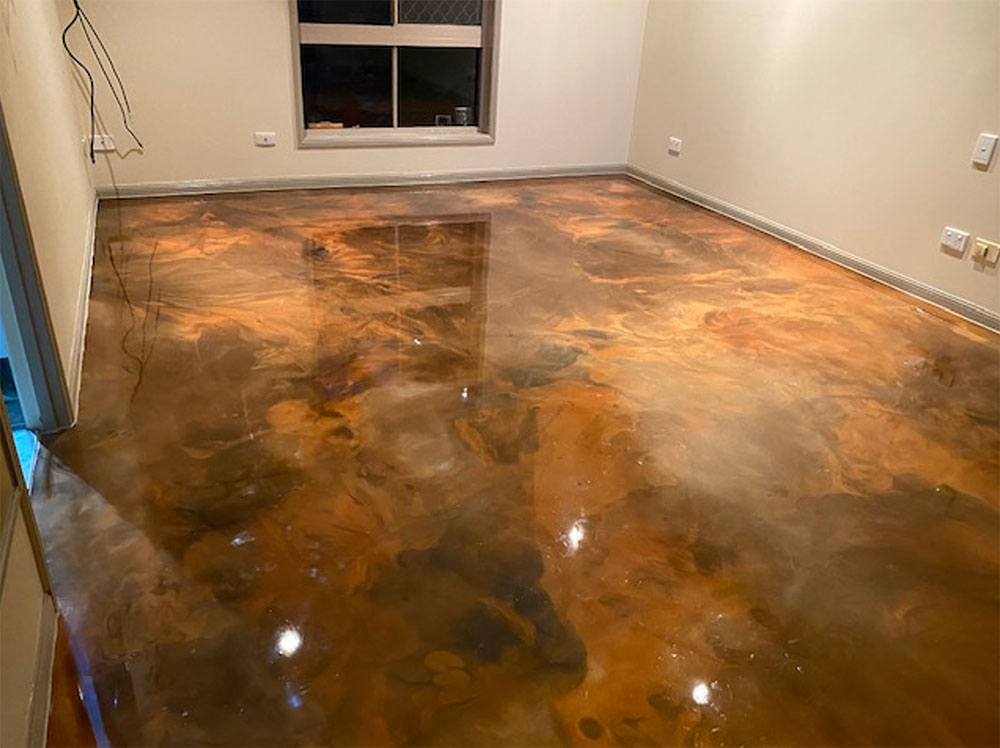Three considerations for a stunning interior epoxy floor

Transform your home with a durable, long-lasting, stunning interior epoxy floor.
Interior designers have adored the sleek, sophisticated finish of polished concrete for years, but there’s a new flooring trend making waves: epoxy.
Epoxy isn’t just for garages and warehouses – it’s a fantastic flooring solution for the entire home. It’s ultra-hygienic and easy to clean, safe and slip-resistant, and 100 per cent customisable to suit your personal taste.
But not all epoxy floors are created equally, and some are significantly more difficult to execute perfectly than others. Metallic, white, and straight-coloured floors are the most challenging – they require the highest technical ability and maintenance.
If you have your heart set on a one-of-a-kind metallic or stark white finish, keep the following three considerations in mind.
1. Your desired aesthetic finish
What overall look are you hoping to achieve? Some like soft and subtle; others loud and bold. The colours you select will determine the mood your floor creates. You might have seen a stunning galaxy-coloured epoxy floor online but remember the image was likely edited.
2. Your substrate
More challenging epoxy finishes are best applied directly to the concrete. If that’s not possible, we can lay the epoxy over sheeting and tiles.
If we can apply the epoxy directly to your concrete slab, be aware of the following:
- Undulating concrete. Undulating concrete is essentially uneven concrete. For example, if there is a hollow or dip in the centre of the room, the natural flow of the epoxy will fill this in – just like water in a bowl. As a result, these areas will develop more character. High spots on your concrete slab will be covered, but there won’t be as much ‘activity.’ These variations can be avoided during the priming stages, but some of the most fantastic-looking floors are created using free-flowing epoxy.
- Quality of concrete. In an ideal world, every slab is laid to an exacting standard. But we don’t live in an ideal world, and many are not. As a result, you might have what we’d call a ‘soft’ or ‘boney’ slab, where the top layer consists of ‘fines’ that have risen to the surface. Soft slabs are typically caused by too much water or various retarders or accelerants added during the laying process. Think of your slab like a blank artists’ canvas – the higher the quality, the better the outcome. All is not lost, however, if your slab is poor quality. We can still achieve excellent results with specialised techniques.
3. Your colour choice
Selecting a colour for your home’s interior flooring is no easy task – and there’s a whole lot more to it than aesthetic preferences.
Our first word of warning: achieving a perfect white floor is just about impossible. No matter what we do to achieve perfection (and there are many steps and processes we implement to achieve incredible finishes), we cannot get there.

The floor above might look perfect, but although we regulated as much as possible, a fly landed on the epoxy when it was wet. When it tried to fly away, it bled onto the floor. The mark takes up less than 0.01 per cent of the floor’s surface, but because of the colour, the flaw is instantly noticeable.
Secondly, consider discolouration. In its raw form, epoxy does not provide UV stability. Here’s what you need to know:
- Lighter colours are more susceptible to ‘yellowing’ than darker colours. White is the worst, followed by light grey.
- Black-base colours like dark grey are less susceptible.
- Browns and earthy tones are the least susceptible to discolouration – they look great too. Check out the metallic floor we created below with shades of brown, gold, and black.

What’s more, some floors are easier to clean than others. Compared to darker multi-coloured floors, single-coloured floors show scuffs and dirt significantly more. Think about the location of your interior epoxy floor – is it in close proximity to outdoor areas? If so, can dirt and debris be contained?
Finally, although we aren’t interior designers, we can offer some advice on creating a cohesive colour scheme throughout your home. When selecting an epoxy colour:
- Choose whites, blacks, and greys with homes that are cooler-toned
- Choose browns, beiges, and creams with homes that are warmer-toned or feature brickwork
We take the guesswork out of colour choice by creating sample boards as part of our process. You can take them home and look at them in all lighting conditions day and night – whatever it takes for you to make a confident decision.
Transform your home with an interior epoxy floor
Epoxy flooring isn’t just practical and hard-wearing – it’s gorgeous to look at and completely customisable. Get in touch with Brisbane and Gold Coast’s epoxy flooring experts today. We’d be happy to help you bring your flooring vision to life.

